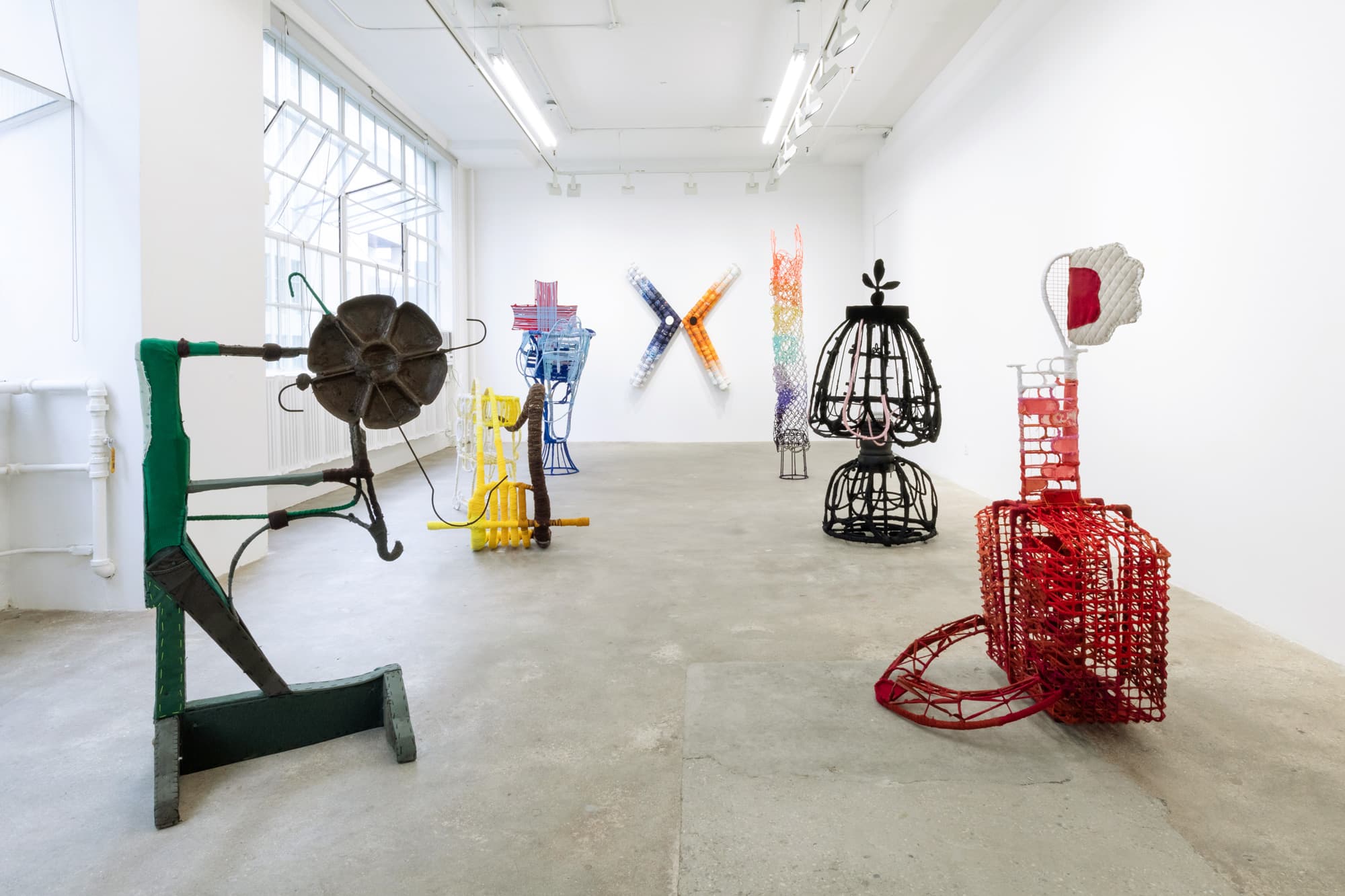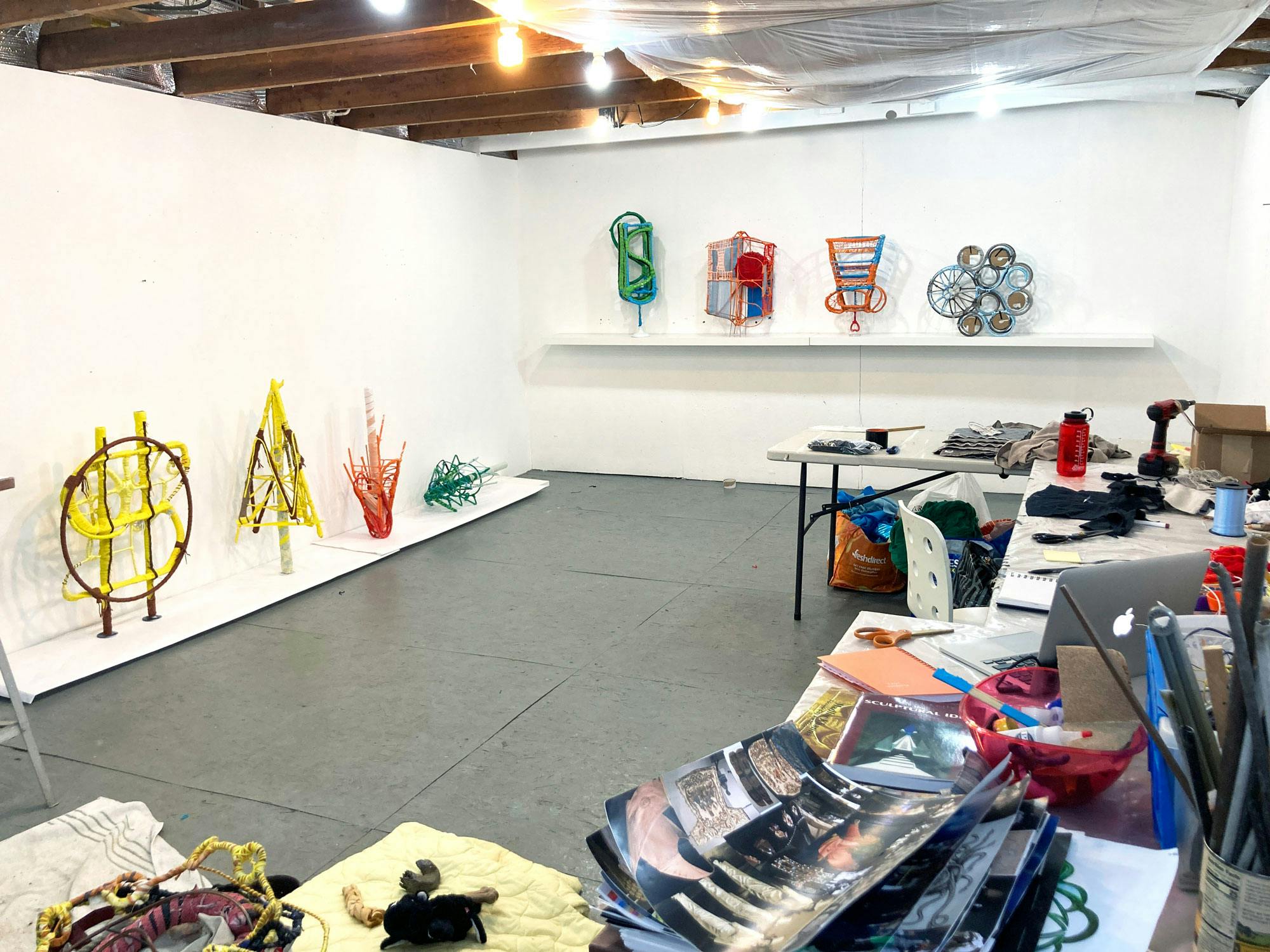Published January 20, 2023
Courtney Puckett Creates a Field of Her Own

Courtney Puckett’s work defies classification. The Hudson Valley-based artist toes the line of both fiber art and sculpture, using textiles extensively in mixed media works that blur the boundaries of art and craft, abstraction and figuration. Her works employ symbols and anthropomorphic shapes alluding to greater meanings and social commentary. Puckett’s work involves an almost therapeutic process of creation as she reconfigures and combines found objects, wrapping the entire composition as if applying a bandage. With her use of repurposed materials, Puckett joins a growing group of artists concerned with the environmental impact of the art industry and solidly aligns herself with the legacy of makers looking to their surroundings for inspiration.
Giving them titles like The Gardener (2019), The Orbiter (2021), and The Changer (2021), Puckett considers her large-scale sculptures as characters that take on occupations or roles in society. These characters often dictate the form of the work, like the round mirrors that appear to be in a constant revolution around the star-shaped frame of The Orbiter. Other works bear legible symbols, such as the yellow dollar sign in $ (2022) and the intertwined “y”, “e”, and “s” that make up Yes (2020). “I see these more as thought bubbles, messages, reflecting interior self or inner dialogue,” explains Puckett. “I like that the work carries a message.”
Indeed, messages abound in Puckett’s work, inviting the viewer in closer to parse each one. In The Changer, white fibers wrap tightly around a tower-like scaffold with a gradient of string changing from blue to green to yellow to orange as it ascends. The top of the tower gives way to a rich red arch. The structure is static, yet its curved frame tricks the eye into thinking the tower is making a slow, swaying motion. Is this motion the change the title refers to? Or perhaps the message is deeper. The red tip appears to glow, reminiscent of a lit match or an electric fuse. The artist herself is a catalyst for change, transforming the materials in an alchemical process of creation. The Changer is one of many sculptures that reveal Puckett’s keen eye for color. The subtle gradient and punch of red are transfixing, as if an electric charge is bursting through the top of the work.
Like many artists with formal training, Puckett began her journey by studying painting. However, she parted ways with the discipline in the early 2000s to seek a more playful, malleable material, which she found in textiles. “It began as an intuitive switch [from painting], and actually quite a rebellious one–I was good at painting and it was (and still is) at the top of the hierarchy of art forms,” she says. “As a very young artist, I decided to take a different path and it required me to embrace fabric as a material.” As she began working with this material that was new to her, Puckett entered into dialogue with the history and contemporary conversations of fiber artists, but always retained her connection to sculpture.
Puckett’s entrée into textiles was at a time when fiber art wasn’t as visible in the art world as it is today. “I had been making work like Sheila Hicks before I knew who she was,” Puckett explains, referencing the American artist who was a pioneer of fiber art in its nascence in the 1960s and continues to excel in the field today. It wasn’t until a formative visit to the Institute of Contemporary Art in Philadelphia in 2011 where she saw the exhibition Sheila Hicks 50 Years that Puckett learned about the artist and began to form connections with the fiber art movement. This visit, supplemented by books like Elissa Auther’s “Hierarchy of Art and Craft” and Glenn Adamson’s “Thinking through Craft”, helped her to articulate the critical issues she had found in working with fabric as an alternative to paint.
In repurposing found materials, Puckett joins another long legacy of artists, a fact she acknowledges and embraces. “Artists sourcing found materials from everyday life is not new. I am thinking of the early twentieth century cubists’ collage and assemblage and the arte povera artists of Europe,” she says. Indeed, some of the most iconic moments in art history over the last century and a half have included found objects, from Marcel Duchamp’s Fountain (1917) to Man Ray’s L’Enigme d’Isidore Ducasse (1920) to Robert Rauschenberg’s Combines (1954-1964).
Unlike some artists working with repurposed objects, the original forms of Puckett’s materials are often impossible to determine. In the few occasions where the works do bear slightly more evidence of their origins, like the hula hoop shape in $, identifying each component isn’t the goal. Individual segments take shape as the artist builds around her chosen objects, using wire, textiles, and wood to create a larger composition. Puckett unifies each part, wrapping disparate components in a skin-like surface of colors and textures.
To transform her chosen materials, Puckett has to remain flexible, allowing the forms of the objects to dictate the parameters of the final sculpture. While she does create drawings that act as two-dimensional roadmaps, these are not preliminary sketches, but rather are guides to inform the process. A shape possible in a drawing may not always be possible in a sculptural form depending on the materials available.
For Puckett, using found materials also connects with a personal legacy. “I studied with the Canal Street generation of artists from the 1980’s who scoured the streets of New York for junk to make artworks. I romanticized those times, when in reality, it was often out of financial necessity and a scarcity of art supplies. Since early in my art making career, I have been intuitively drawn to using found material. The formal qualities inherent in what already exists, along with the history and cultural significance of the stuff, are welcome challenges,” she explains, adding that sustainability is also a factor. Although the art industry has a smaller impact on climate change than fields like fashion, Puckett has made her environmental commitment a central part of her practice. Whereas in the past she may have purchased items that fit an idea for a sculpture, like a hula hoop, Puckett now sources materials she can repurpose. She also joined the collective Artists Commit, one of many groups that have emerged in the last few years to share tips on how to maintain a sustainable practice and hold galleries and institutions accountable to do the same.
While her use of textiles and found materials connects Puckett with several ethos and legacies throughout art history, her work is undeniably distinct. The objects she transforms take on new lives as she carefully wraps each creation into a character. The deeper one looks into Puckett’s practice, the more nuanced her work becomes. Though textiles are central to her work, she pushes the limits of every formal element, achieving something that exists beyond fiber art and conceptual art, beyond painting and sculpture. Ultimately, Puckett’s work is uniquely her own.
Learn more about Courtney’s practice and works now available on Testudo here.

